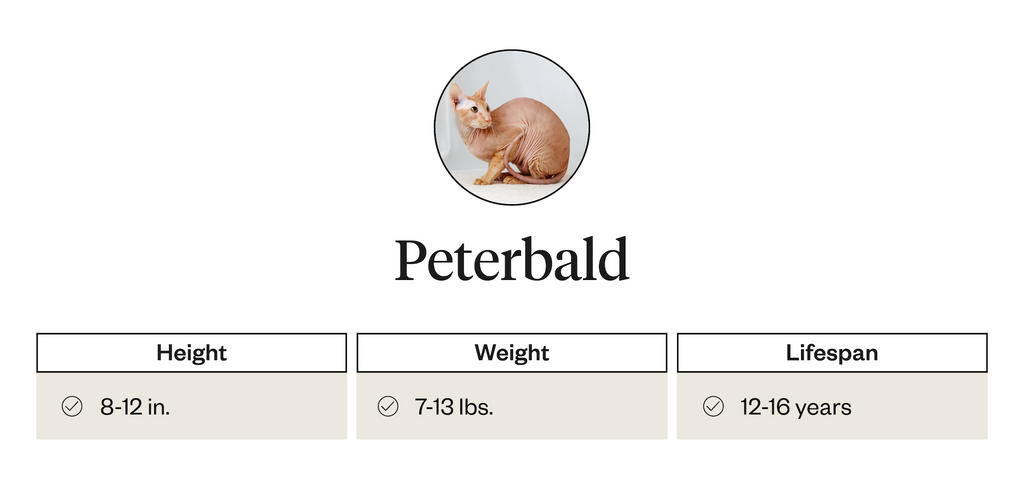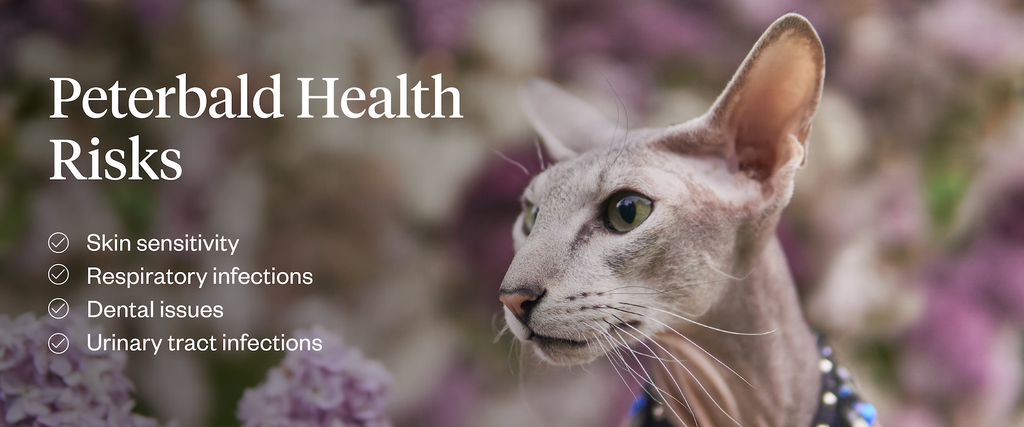8 Min Read
Peterbald: Pet Profile
Key takeaway

Why pet owners are switching to online vet care with Dutch
-
Prescriptions delivered free to you
-
Fast access to Licensed Vets over video
-
Unlimited video visits and follow-ups
Follow along as we dive into the fascinating world of Peterbald cats. These felines are renowned for their distinct velvety coats, striking facial features, and endearing personalities. Let's take a closer look at their history, physical traits, behavioral characteristics, common health risks, and more to uncover their charm and allure.
- History & Origin Of Peterbald Cats
- Physical Attributes Of Peterbald Cats
- Behavioral Characteristics Of Peterbalds
- Peterbald Breed Health Risks
- Caring For A Peterbald
- Peterbald Cats: FAQs
- Final Notes
History & Origin Of Peterbald Cats
The Peterbald cat has a fascinating history, stemming from the visionary efforts of Russian breeder Olga Mironova. Her aim was to create a feline with a long body and versatile front paws, which led her to crossbreed the Oriental Shorthair and the Don Sphynx.1
This unique breed came into existence in the early 1990s and was officially recognized as a distinct breed by the International Cat Association (ICA) in 1997. It wasn't until 2005 that the Peterbald attained Championship status. Despite its reputation as a naked cat breed, the Peterbald showcases a wide array of coat variations due to its diverse genetics, making each encounter with these cats a captivating and unique experience.1
Physical Attributes Of Peterbald Cats

You can spot a Peterbald by its lean body, large, pointy ears, angular head, long tail, and almond-shaped head. This cat is generally known as hairless, though there are actually five different types of coats that a Peterbald might have. They typically weigh about 7 to 13 pounds and are 8 to 12 inches tall. They can come in any variety of color combinations, and they live for around 12 to 16 years.
Peterbalds have very little hair thanks to a genetic mutation. For the mutation to produce a cat with no hair, there must be two copies of the mutated gene (known as hr) present. If one Peterbald cat has just one copy present, then they will have a coat with more hair.2 The five types of coat include:
- Naked (entirely hairless)
- Chamois (Peach fuzz)
- Flock (Fine velvet)
- Brush (Wiry)
- Straight (Normal short hair)2
Behavioral Characteristics Of Peterbalds
Peterbald kittens and cats tend to be very social, and they’re known for getting along with dogs, kids, and other cats alike. If you’re looking for a lap cat, then Peterbalds are likely the ones for you. One thing to keep in mind is that they often have strong preferences, which means it can be a little disappointing if they favor another family member over you.
In general, you can expect a peterbald to be curious and very interactive. Many will follow around their owners, even perching on their shoulders to avoid the exercise. They’re smart, and they need a lot of stimulation, meaning you’ll want to avoid leaving them for very long.
Peterbald Breed Health Risks

Peterbald cats, while captivating, do have some potential health concerns that owners should be aware of. Their hairless skin is particularly sensitive and vulnerable to sunburn and abrasions, necessitating sun protection and gentle handling. Respiratory infections can be a concern due to their hairlessness, as they lack the natural insulation that fur provides.
Dental problems can also arise, so regular oral hygiene and dental check-ups are essential. Additionally, Peterbalds can be prone to urinary tract infections, emphasizing the importance of a balanced diet and proper hydration. While these health risks are not uncommon among cats, attentive care and routine veterinary visits can help mitigate these issues and ensure a happy, healthy life for your Peterbald companion.
Caring For A Peterbald
Caring for a Peterbald cat is not entirely different from caring for another breed of cat, though you will need to know a few special facts about how to care for their unique coats .
Diet & Nutrition
A Peterbald will need the same amount of meat that any other cat will. The general rule of thumb is to give them at least 40% protein at most 10% carbohydrates.3 If you’re looking for ways to incorporate more water into your meals, canned (wet) food is an excellent source of hydration. Dry cat food is by definition low moisture, and cats are accustomed to getting most of their water from their food. Magnesium, iron, and Vitamins A, B, C, D, E, and K2 can help cats maintain better health. If you’re looking for complete and balanced pet food, you can either make your own with the help of a veterinarian or choose one that’s approved by the Association of American Feed Control Officials (AAFCO).
Grooming
As mentioned above, Peterbalds are more susceptible to infection. Their hairlessness makes for moist skin, which is the perfect environment for a fungus to thrive. Unlike most cats, who will be able to groom themselves, you will need to bathe them regularly to remove the oils and prevent skin conditions. Peterbalds can also benefit from moisturizer like coconut oil or sunscreen for pets. Because they’re more likely to burn in the sun, you may have to keep them away from direct contact with the hot rays.4
When the winter rolls around, it will be equally important for Peterbald kittens and cats to have access to warm areas. Because they’re sensitive to fluctuating temperatures, this cat won’t have the internal temperature regulation that a standard domestic cat will have. Finally, you’ll need to keep their ears free from excessive earwax and eyes from discharge. If you want to be proactive about their dental care, consider brushing their teeth once a week or using a dental rinse or treats that are designed to remove plaque and tartar from their teeth. This can end up saving you a lot of money on professional cleanings when your cat gets a good bill for dental health.
Exercise & Enrichment
Playing with your cat is not only a fun way for you to bond, it’s also the best way to keep them active. The Peterbald is an intensely intelligent cat, and without exercise and play, they’re likely to make their own fun. Instead of letting them get in your shoe closet or under your bed, you should be engaging with them at least 20 to 60 minutes per day.
Consider how cat toys, scratch mats, catios, and cat trees can supplement direct interactions with you as well. When they have everything they need in the house, they’re more likely to leave your things alone. Also, even if Peterbalds are more susceptible to sunburn, that doesn’t mean they can’t enjoy some supervised outdoor fun.
Preventative Care & Veterinary Checkups
Preventative care and vet checkups are crucial to your Peterbald’s health, especially when they are either very young or on the older side. Before they’re four months old, many experts recommend having them visit the vet every few weeks. Kittens will need to be dewormed regularly until they’re around six months of age. Adult cat owners are urged to keep litter boxes clean to prevent roundworm, hookworms, and tapeworms. You can also consider treatments like Revolution Plus, a topical application that can protect Peterbalds from ticks, heartworm, ear mites, fleas, roundworms, and hookworms, or Bravecto, which can protect a cat from fleas and ticks for up to 12 weeks. Finally, vets recommend having fecal exams at least twice a year for adult cats.
Once they get to be around 8 or 9, they should be going to the vet at least twice a year (more if they’re prone to serious conditions). The best way to care for them at home is to focus on their diet and pay attention to their daily habits. If they have problems eating or using the litter box or they start to become listless for any reason, it may be a good reason to at least call your vet to see what’s happening. Other signs of illness include discharge from their ears, eyes, and nose as well as vomiting, coughing, and lameness.
Peterbald Cats: FAQs
Do all Peterbald cats have no hair?
Not every Peterbald cat is bald, despite their name. Peterbalds may have fine hair, coarse hair, or sparse hair. Some won’t have traditional hair at all but more of a peach fuzz that covers their whole body. If you have a Peterbald with a straight coat, it’s because the cat didn’t have two copies of the same mutated gene.
How often should I bathe my Peterbald cat?
We recommend bathing your Peterbald every 1 to 2 weeks. Your Peterbald cat, no matter what type of coat it has, may be more susceptible to dirt and grime than other cats. Keeping them clean will drastically reduce the odds of having to deal with an infection.
Are Peterbald cats hypoallergenic?
No. There is no such thing as an entirely hypoallergenic cat. Your allergies could be triggered by the skin, saliva, or urine of your pet. However, because a Peterbald sheds less, these cats may be less likely to set off allergies.

Final Notes
Peterbald cats may not have been around for very long, but they’ve made a big impression on many cat lovers. Their generally intelligent and friendly demeanor has made them an excellent fit for families of every variety. While they may be a little more work than a standard shorthair, their unique profile, coat, and personality more than make up for the additional time you’ll spend to keep them healthy.
When you calculate the costs of pet ownership, you have to take into account more than the direct expenses. If you’re looking for a way to supplement and streamline your pet care, consider how Dutch’s telemedicine for pets service could fit into your routine. With us, you have access to licensed veterinarians who can diagnose your pet’s symptoms before creating a custom treatment plan. Starting at just $6 per month, you can pick the right prescription plan for you and your furry friend. Whether you want to keep expensive in-person vet visits to a minimum or just skip the line at the pharmacy, caring for your cat can be a little easier with the right prevention and support. Try Dutch today!
Share
References
-
Oriental Cat Club. "Peterbald Cat History." Accessed October 1, 2023. https://www.orientalcat.eu/peterbald-cat-history.
-
The International Cat Association. "Peterbald Breed Standard." Accessed October 1, 2023. https://www.tica.org/phocadownload/pd.pdf.
-
Texas A&M University College of Veterinary Medicine & Biomedical Sciences. "Cats Are Carnivores, So They Should Eat Like One." Accessed October 1, 2023. https://vetmed.tamu.edu/news/pet-talk/cats-are-carnivores-so-they-should-eat-like-one/.
-
WebMD. "What to Know About a Peterbald." Accessed October 1, 2023. https://www.webmd.com/pets/cats/what-to-know-about-a-peterbald.

